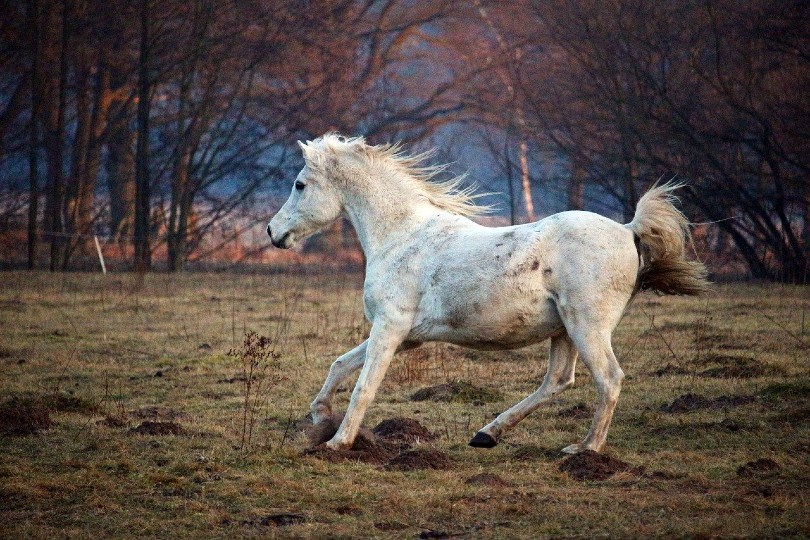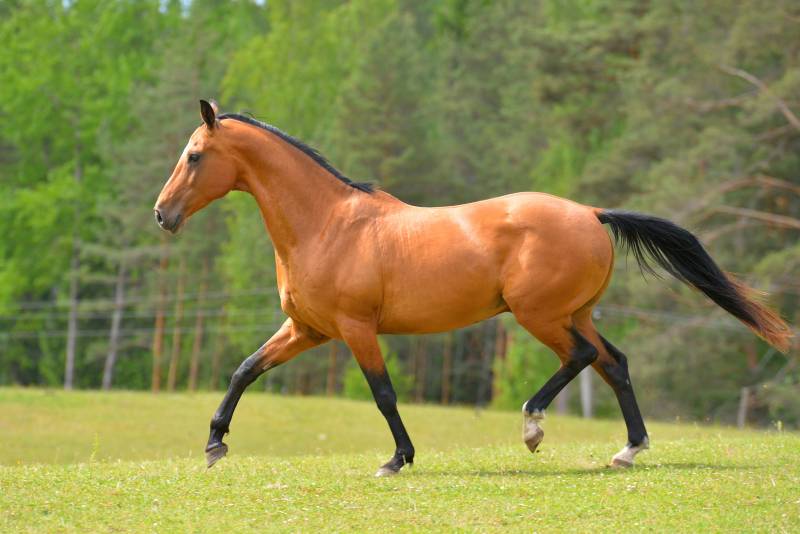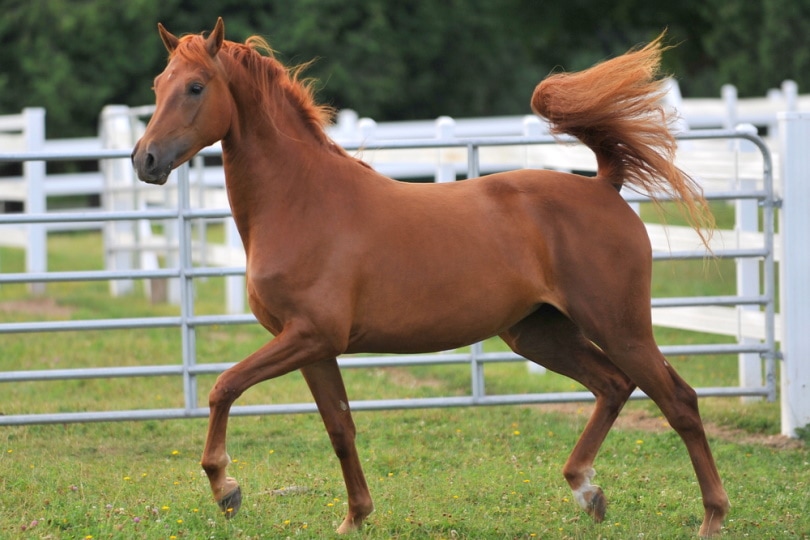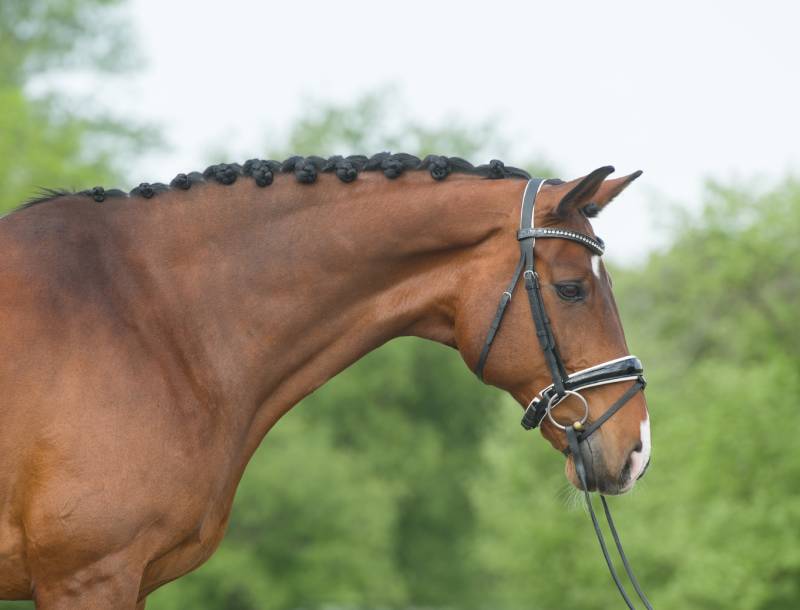
Click to Skip Ahead
A horse’s resilience is an awe-inspiring trait, signifying the true test of their strength and stamina. The annals of equine history bear testament to the immense capabilities of numerous horse breeds, each demonstrating extraordinary endurance.
Here, we cast a spotlight on 10 such breeds. We talk about their unique characteristics, histories, and inherent abilities that make them the epitome of endurance.
How Are Endurance Horse Breeds Classified?
Endurance horse breeds are classified based on their ability to sustain long periods of physical activity without significant fatigue. This includes long-distance racing and other athletic events.
These breeds have naturally or selectively been bred to display superior stamina, hardiness, and recovery abilities. Many factors play into this, including the breed’s genetic history, physical attributes, and environmental adaptation.
The 10 Endurance Horse Breeds
1. Arabian

| Origin: | Arabian Peninsula |
| Lifespan: | 25–30 years |
| Height: | 14–15 hands |
Sporting a spirited elegance, the Arabian horse reigns supreme in the realm of endurance riding. Nurtured in the heart of the Arabian Peninsula, these horses have carved out a niche in endurance racing, demonstrating an unrivaled blend of agility, speed, and resilience.
The Bedouin tribes laid the foundation of this breed, venerating them for their enchanting beauty, captivating grace, and most notably, impressive stamina. These qualities place the Arabian horse in the upper echelons of the endurance sports arena, where they frequently outperform competitors in major events.
2. Akhal-Teke

| Origin: | Turkmenistan |
| Lifespan: | 20–25 years |
| Height: | 14–16 hands |
When it comes to an endurance horse breed steeped in history and prestige, the Akhal-Teke from Turkmenistan surely steals the show. The breed’s unique metallic sheen is a visual treat, while their speed and endurance are unmatched.
Bred by Turkmen tribes for myriad purposes, including raiding, war, and long-distance riding, the Akhal-Teke breed is seasoned in harsh desert conditions, showcasing an uncanny survival instinct. This breed’s remarkable qualities equip them well for endurance riding events, demonstrating stamina and tenacity that leaves a lasting impression.
3. Mustang

| Origin: | North America |
| Lifespan: | 15–20 years |
| Height: | 14–15 hands |
The free-spirited Mustangs of North America showcase a natural talent for endurance that could potentially give Arabian horses a run for their money. Their ancestors underwent the trial by fire of natural selection, forging an incredibly resilient and hardy breed.
In the 2018 Tevis Cup, two formerly wild Mustangs placed among the top 10, reaffirming the breed’s innate capability for endurance racing. Today, Mustang herds continue to roam free in the Western United States, their numbers monitored and managed by the Bureau of Land Management.
4. Anglo-Arabian

| Origin: | France |
| Lifespan: | 25–30 years |
| Height: | 15–17 hands |
With the poise of a king and the speed of an athlete, the Anglo-Arabian is a fusion of majesty and performance. This equine delight was a creation of French horse connoisseurs, a successful blend of the Thoroughbred’s power and the Arabian’s stamina.
This breed is so versatile that they excel in numerous equestrian disciplines, endurance riding being one of them. They possess the grace and endurance of their Arabian ancestry while offering the added strength and speed of their Thoroughbred lineage. When elegance meets power, the Anglo-Arabian is the result!
5. Mongolian Horse

| Origin: | Mongolia |
| Lifespan: | 20–30 years |
| Height: | 12–14 hands |
Endurance is in the DNA of the Mongolian Horse. This sturdy equine was an instrumental part of Genghis Khan’s formidable cavalry, allowing them to traverse large swathes of land at speed. Centuries of selective breeding in the extreme climate of the Mongolian steppe have culminated in a breed that possesses an extraordinary ability to adapt and endure.
From the daunting Gobi Desert to the chilling Siberian tundra, these horses are ready for it all. Their enduring spirit, combined with a resiliency shaped by a tough environment, makes them an enduring symbol of Mongolia.
6. Quarter Horse

| Origin: | United States |
| Lifespan: | 20–30 years |
| Height: | 14–16 hands |
Famed for their ability to sprint short distances with unrivaled speed, the Quarter Horse may seem an unlikely candidate for endurance racing. However, this versatile American breed can certainly hold their own in long-distance competition. The Quarter Horse’s mental fortitude is as impressive as their physical stamina, making them an all-around winner.
They exhibit a remarkable willingness to perform, paired with the muscular build required for sustained effort. This breed’s adaptability and stamina are a testament to their well-rounded capabilities, demonstrating that a sprinter can also be an endurance star when called upon.
7. Marwari

| Origin: | India |
| Lifespan: | 20–30 years |
| Height: | 14–16 hands |
A native breed of India, the Marwari horse is as resilient as they are royal. Originating in the Marwar region of India, this breed comes with a history steeped in warfare, where their speed and endurance made them an ideal choice for the battlefield.
Now, these equine warriors are transforming their battlefield prowess into endurance running. Their distinct inward-turning ear tips and courageous spirit make them stand out in any equestrian crowd, proving that the endurance arena is not just for the traditional breeds!
8. Missouri Fox Trotter

| Origin: | United States |
| Lifespan: | 20–30 years |
| Height: | 14–16 hands |
With a smooth gait that seems to dance over the miles, the Missouri Fox Trotter has gained a reputation as the mount for those seeking comfort in long-distance riding. This American breed is no stranger to traversing vast terrains.
Their unique fox trot gait provides a steady, rhythmic cadence that is less jarring for riders, perfect for lengthy endurance rides. With their rhythmic gait and ability to cover considerable distances at a comfortable pace, these horses are indeed a sight to behold in an endurance setting.
9. Morgan Horse

| Origin: | United States |
| Lifespan: | 20–30 years |
| Height: | 14–15 hands |
When Justin Morgan had a horse named Figure, he likely had little idea that this equine would serve as the foundation for a breed recognized for their versatility and stamina! From fieldwork to carriage duties, the Morgan horse proved their worth day in and day out, demonstrating an uncanny ability to adapt to a wide range of tasks.
This same versatility and endurance carry over into endurance racing. Horses like “Silver Valley Tate,” which made a mark at the 2018 Tevis Cup, are evidence of the breed’s impressive stamina, proving that a Morgan horse is as much a showman on an endurance course as they are on a farm.
10. Hanoverian

| Origin: | Germany |
| Lifespan: | 25–30 years |
| Height: | 16–18 hands |
Known for their finesse in dressage and jumping, Hanoverians are perhaps unexpected entrants in endurance racing. However, they’re a prime example of not judging a book by its cover or in this case, a horse by their traditional roles. Going back to their roots as military horses and carriage pullers, Hanoverians possess a surprising amount of endurance.
Take Ken Campbell’s Hanoverian mare, Fantazia. While she was pulled from the 2018 Tevis Cup partway through, her participation showed that these horses can break from their traditional molds, pushing boundaries and expectations. So, if you are an owner of an unconventional breed for endurance, keep in mind that with the right training and care, their potential is vast!
Going the Distance: Choosing Your Equine Partner
Before making a beeline for the endurance racing world, it’s essential to understand that not all horses are created equal. Some breeds are naturally more inclined toward endurance riding due to their physical attributes, temperament, and historical lineage. That said, every horse is an individual and can surpass their breed’s general characteristics with proper training and a nurturing environment.
Endurance riding is not solely about speed; it’s about a horse’s ability to sustain a steady pace over long distances. Stamina, heart rate recovery, and soundness are key factors to consider.
Additionally, a bond between the rider and horse is paramount. Long rides will be easier and ultimately more successful if the horse and rider understand and trust each other.
Conclusion
In the end, it’s not just about the breed, but the individual horse’s heart and spirit. A horse’s love for running, their bond with their rider, and the training that they undergo can transform even the most unexpected breed into a successful endurance racer.
Endurance horses can hail from any corner of the world and any breed. So, whether you’re entrusting your journey to the swift legs of an Akhal-Teke or finding an unlikely partner in a Hanoverian, remember that the world of endurance riding is vast and full of opportunities.
Featured Image Credit: rihaij, Pixabay









